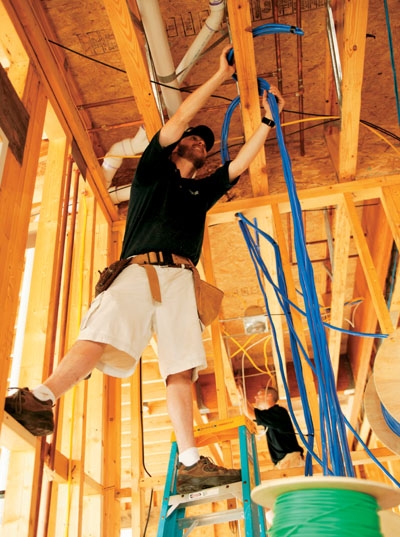A Day in the Life of a Custom Installer Page 4

GETTING WIRED Okay, where do we put the starting point for all wire runs? For a music system, it's usually near the electronics. We mount structured wiring panels between studs in a discrete location, like in a closet, laundry room, or garage. Then, as a crew, we walk through the job with the home-owner, marking where wire needs to go. This ensures that everyone is on the same page and allows for any last-minute changes or additions.
Once the walk-through is done, the work begins in earnest, typically starting with nailing up wall boxes, picking out the best routes for running wires in a trunk line, and drilling holes. With a retrofit, this usually means climbing around in attics or worming our way through crawl spaces. Believe me, spending a couple of hours in an attic on a hot South Carolina day is never fun.
If we have to run wire to many rooms, we'll bring three or four spools of each kind of wire. Runs of bundled 16/4 (16-gauge speaker cable with four conductors) and Cat-5 are pulled to each room that will get a volume control or a keypad controller. At speaker locations, we prefer to install mounting brackets (similar to light cans) since they eliminate the mess of cutting holes later and ensure that the ceiling layout won't be changed (lights moved, framing added). Structured wiring bundles of two RG-6 coax cables and two Cat-5E data cables are pulled to each TV location. When pulling Cat-5E wires to phone and Ethernet locations, we use two colors to speed the trim out. Home theaters require special cabling, including a host of video wiring to the display. Thicker-gauge wiring is used to support the more powerful amplification there.
Ideally, we're the last trade on the job, arriving just before the insulation is installed. This lets us steer clear of electrical cabling or, if we can't avoid it, to cross it at 90° angles so we won't pick up any interference. Two other wiring no-nos are making tight bends or putting kinks in cabling, as both can reduce performance.
Some beams can't be drilled - or can be drilled only with certain bits, due to building codes. Some ceilings require plenum-rated wire to prevent noxious fumes in case of fire. After the wiring is done, we install nail guards to keep sheetrockers from damaging runs and use fire caulk to fill drilled holes. Knowing what can and can't be done is crucial to passing an inspection.




























































